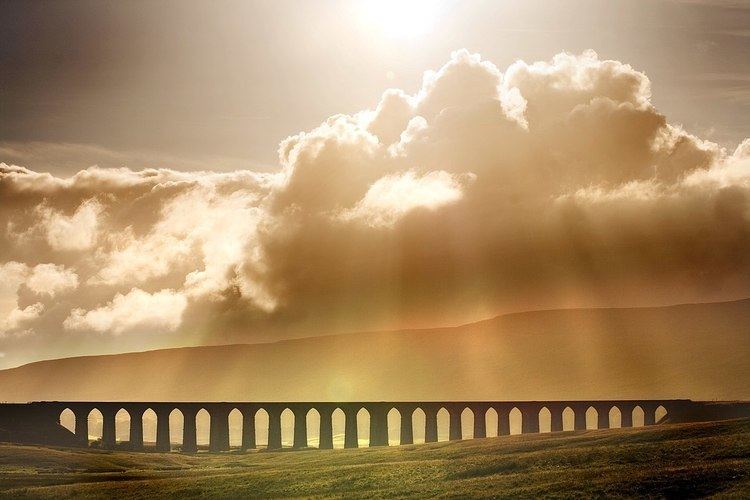Crosses Batty Moss No. of spans 24 Construction begin 12 October 1870 Height 32 m Architect John Sydney Crossley | Designer John Sydney Crossley Opened 3 August 1875 Total length 400 m | |
 | ||
Similar Whernside, Ingleborough, Yorkshire Three Peaks, Pen‑y‑ghent, Ribblehead railway station | ||
Ribblehead viaduct and steam train from the air by quadcopter
The Ribblehead Viaduct or Batty Moss Viaduct carries the Settle-Carlisle Railway across Batty Moss in the valley of the River Ribble at Ribblehead, in North Yorkshire, England. The viaduct, built by the Midland Railway, is 28 miles (45 km) north-west of Skipton and 26 miles (42 km) south-east of Kendal. It is a Grade II* listed structure.
Contents
- Ribblehead viaduct and steam train from the air by quadcopter
- Black five s ribblehead viaduct 23rd january 2016
- History
- Description
- Location
- Usage
- In popular culture
- References
The land underneath and around the viaduct is a scheduled ancient monument. The remains of the construction camp and navvy settlements (Batty Wife Hole, Sebastopol, and Belgravia) are located there.
Black five s ribblehead viaduct 23rd january 2016
History
The viaduct was designed by engineer John Sydney Crossley. The first stone was laid on 12 October 1870 and the last in 1874. One thousand navvies built the viaduct and established shanty towns on the moors for themselves and their families. They named the towns after Crimean War victories, well-to-do districts of London and biblical names. There were smallpox epidemics and deaths from industrial accidents. Around one hundred navvies were killed during its construction. There are around 200 burials of men, women, and children in the graveyard at Chapel-le-Dale dating from the time of its construction. The church has a memorial to the railway workers.
The line over the bridge was opened to goods traffic on 3 August 1875, but passenger trains did not commence running until 1 May 1876, following approval of the works by Colonel F. H. Rich, an Inspecting Officer of the Board of Trade.
In 1964, several brand new Humber cars landed on the ground after being blown off their wagons while being carried over the viaduct on a freight train.
Description
Ribblehead Viaduct is 440 yards (400 m) long, and 104 feet (32 m) above the valley floor at its highest point. It is made up of twenty-four arches of 45 feet (14 m) span, with foundations 25 feet (7.6 m) deep. Every 6th pier is 50% thicker to mitigate against complete collapse should any pier fail. The north end of the viaduct is 13 feet (4.0 m) higher in elevation than the south end leading to a gradient of 1:100. 1.5 million bricks were used in the construction and some of the limestone blocks weigh 8 tons each.
Location
Ribblehead Viaduct is the longest on the Settle-Carlisle Railway. Ribblehead railway station is less than half a mile to the south and to the north is the Blea Moor Tunnel, the longest tunnel on line. It is near the foot of Whernside.
The Settle-Carlisle Line is one of three north-south main lines, along with the West Coast Main Line through Penrith and the East Coast Main Line via Newcastle. British Rail attempted to close the line in the 1980s, citing the reason that the viaduct was unsafe and would be expensive to repair. A partial solution was to single the line across the viaduct in 1985, preventing two trains from crossing simultaneously. A 30 mph speed limit is also in force. The closure proposals generated tremendous protest and were eventually retracted. The viaduct, along with the rest of the line, was repaired and maintained and there are no longer any plans to close it.
Two taller viaducts on the route are Smardale Viaduct at 131 feet (40 m) high and near to Crosby Garrett, and Arten Gill at 117 feet (36 m).
Usage
In 2016 the line and viaduct carries six passenger trains from Leeds to Carlisle per day in each direction, plus regular long distance excursions, many hauled by steam locomotives. Regular diesel-hauled heavy freight trains also use the route to help reduce congestion on the West Coast Main Line. Colas Rail operate a timber train most Friday afternoons which passes over the Viaduct when it departs its yard opposite Ribblehead railway station. The combination of the rarely seen timber train and the British Rail Class 56 locomotives used to pull the train has built quite an enthusiastic following.
In popular culture
The building of the viaduct was the inspiration behind the ITV period drama series Jericho. The viaduct appears in the 1970 film No Blade of Grass and also in the 2012 film Sightseers.
